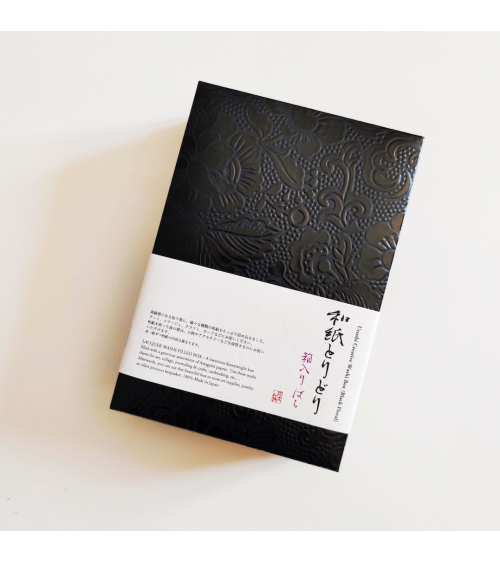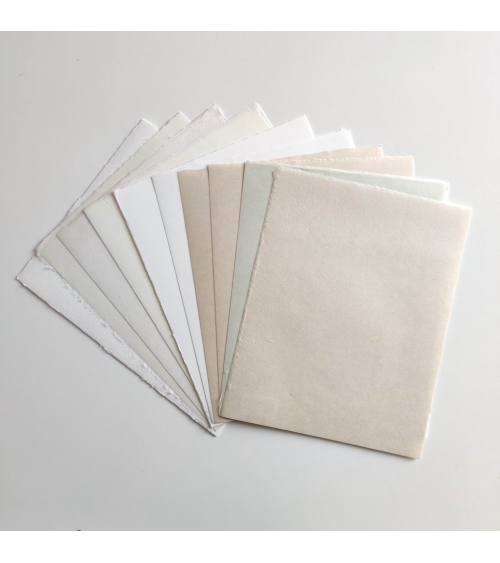Japanese paper
JAPANESE PAPER
Washi. The Japanese paper (or rice paper without rice)
The Japanese paper, washi or wagami, is also known in Europe as rice paper.
Curiously, there is no rice in the composition of the Japanese paper, but a series of plants native of the regions where this paper was traditionally made, by hand and exclusively handcrafted.
Among the selected plants the main one is a kind of mulberry, the kozo (Broussonetia papyrifera). There is as well the gampi, the mitsumata and the one called tororo aoi, from which a gelatinous component is extracted (Neri). It helps with the cohesion of the paper ingredients.
Nowadays, it is difficult to have access to the authentic Japanese paper in our country, even in cities such as Madrid, Barcelona or Valencia. Consequently, in order to get you closer to this type of paper, so beloved by craftsmen and artists around the world, on our online store there is a section of “Japanese Paper”. It offers naturally made papers as well as Chiyogami and Katazome decorative papers, or papers to use for calligraphy and other graphical arts (engraving, xylography). Visit this section to find your delights.
Characteristics
One of the characteristics of the washi paper is that it has a higher degree of resistance than most papers from other parts of the world this phenomenal is due to its fabrication process. After a cooking phase, the wood fibers are mashed with great hammers or wooden mass, there are not shredded as it usually happen with other products. Thus, the kozo fibers keep a longitude up to 100mm, which gives the washi its unique resistance.
It has a low acidity, which makes it a very stable paper that remains unaltered for hundreds of years.
Its composition and its detailed production process, make the Japanese paper a product of warm, delicate and rustic appearance. At the same time these papers are soft yet not cold. You can even feel the fibers of the bushes the papers come. In fact, in some cases, intentionally thick fibers are incorporated or even small pieces of bark. They render to each sheet a unique design.
The different degrees of thickness of the paper also have very special characteristics. They can be used in different ways in order to produce unique effects on light, ink, etc.
Types
Nowadays the washi paper or Japanese paper is handmade using the same process used more than a thousand years ago, as well as using machineries. This is why there is a wide variety of products that can adapt to many specifications and budgets.
If you are interested in papers made entirely by hand, whether in the production or the decorative aspect, you can choose our katazomes. They preserve through their motifs the secrets of craft traditions dating back several centuries ago.
If you want a richly decorated handmade paper, with very stable pigments and you prefer to choose from a wide variety of patterns and colors, the machine-made washi, the Chiyogami (or millenary paper) is your choice.
If you like unique products, choose rakusui paper. It is made from very long fibers. Its patterns are designed by the effect of drops of water flowing nonchalantly through the board while still on the frame.
If you are looking for a medium to express yourself, you can choose from the colors of mingeishi (popular) paper. They are made directly with a raw dyed fabric. You can still choose one of our most natural fabrics: Yamato and Bark kozo. They have small pieces of bark or one of our calligraphy and graphic arts papers.
Uses
Thousands of ideas gather in our heads when we find ourselves in front of a washi board.
Papers with a low-grade weight are widely used in aircraft modeling and restoration.
As for decorated papers, they are used in the world of arts and crafts, in binding books, to cover small furniture, jewelry, decoration, scrapbooking and, of course, origami.
The papers with the texture and water marks are perfect with regard to the "light sets" for lamps, window decoration etc.
The calligraphic paper is very solicited for its use with techniques shodo (Japanese calligraphy) and sumi-e (Japanese watercolor).
























